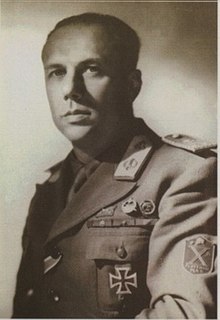Junio Valerio Borghese
| Junio Valerio Borghese | |
|---|---|

Junio Valerio Borghese
|
|
| Honorary President of the Italian Social Movement | |
|
In office 1951–1954 |
|
| Preceded by | none |
| Succeeded by | Augusto De Marsanich |
| Personal details | |
| Born |
Junio Valerio Borghese June 6, 1906 Rome, Lazio, Italy |
| Died | August 26, 1974 (aged 68) Cádiz, Andalusia, Spain |
| Resting place | Basilica di Santa Maria Maggiore |
| Nationality | Italian |
| Political party |
National Fascist Party (1926–1943) Italian Social Movement (1946–1967) National Front (1968–1970) |
| Spouse(s) | Daria Vasilievna Schouvalova (m. 1909; her death 1963) |
| Children | 4 |
| Alma mater | Italian Naval Academy |
| Profession | Military officer |
| Awards | Gold Medal of Military Valour |
| Military service | |
| Nickname(s) | The Black Prince |
| Allegiance |
|
| Service/branch | |
| Years of service | 1928–1945 |
| Rank | Frigate captain |
| Unit | Decima Flottiglia MAS |
| Commands | Decima Flottiglia MAS |
| Battles/wars |
Mediterranean campaign, Raid on Alexandria |
Junio Valerio Scipione Ghezzo Marcantonio Maria Borghese (6 June 1906 – 26 August 1974), nicknamed The Black Prince, was an Italian Navy commander during the regime of Benito Mussolini's National Fascist Party and a prominent hard-line fascist politician in post-war Italy. In 1970 he took part in the planning of a neofascist coup (dubbed the Golpe Borghese) that was called off after the press discovered it; he subsequently fled to Spain and spent the last years of his life there.
Junio Valerio Borghese was born in Artena, Province of Rome, Kingdom of Italy. He was born into a prominent noble family of Sienese origin, the House of Borghese, of which Pope Paul V was a notable member. His father, Livio Borghese, was the 11th Prince of Sulmona and younger brother to the more famous Scipione Borghese. Borghese was the second son of the prince and, as such, had the title of Patrician of Rome, Naples and Venice and the style of Don Junio Valerio Borghese. However, the press and the anglo-saxon historiography routinely used the incorrect style Prince Junio Valerio Borghese. Borghese was first educated in London, England, and, from 1923, he attended the Royal Italian Navy Academy (Accademia Navale) in Livorno.
In 1929, the naval career of Borghese began. By 1933, he was a submarine commander. Borghese took part in the Second Italo-Abyssinian War. During the Italian intervention in the Spanish Civil War, he was in command of the submarine Iride, where he allegedly lost two seamen after his unit was depth-charged by the British destroyer HMS Havock.
...
Wikipedia
